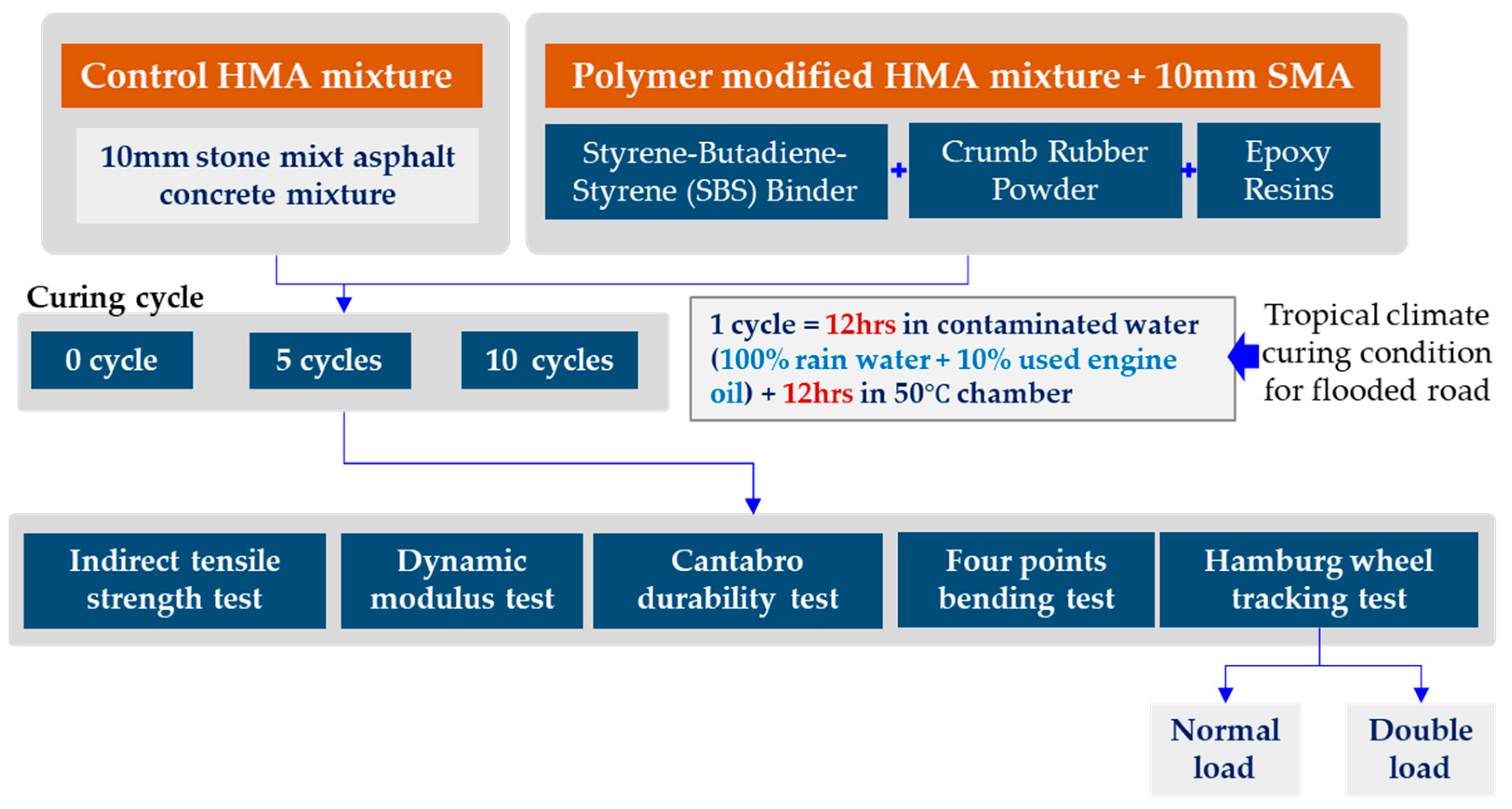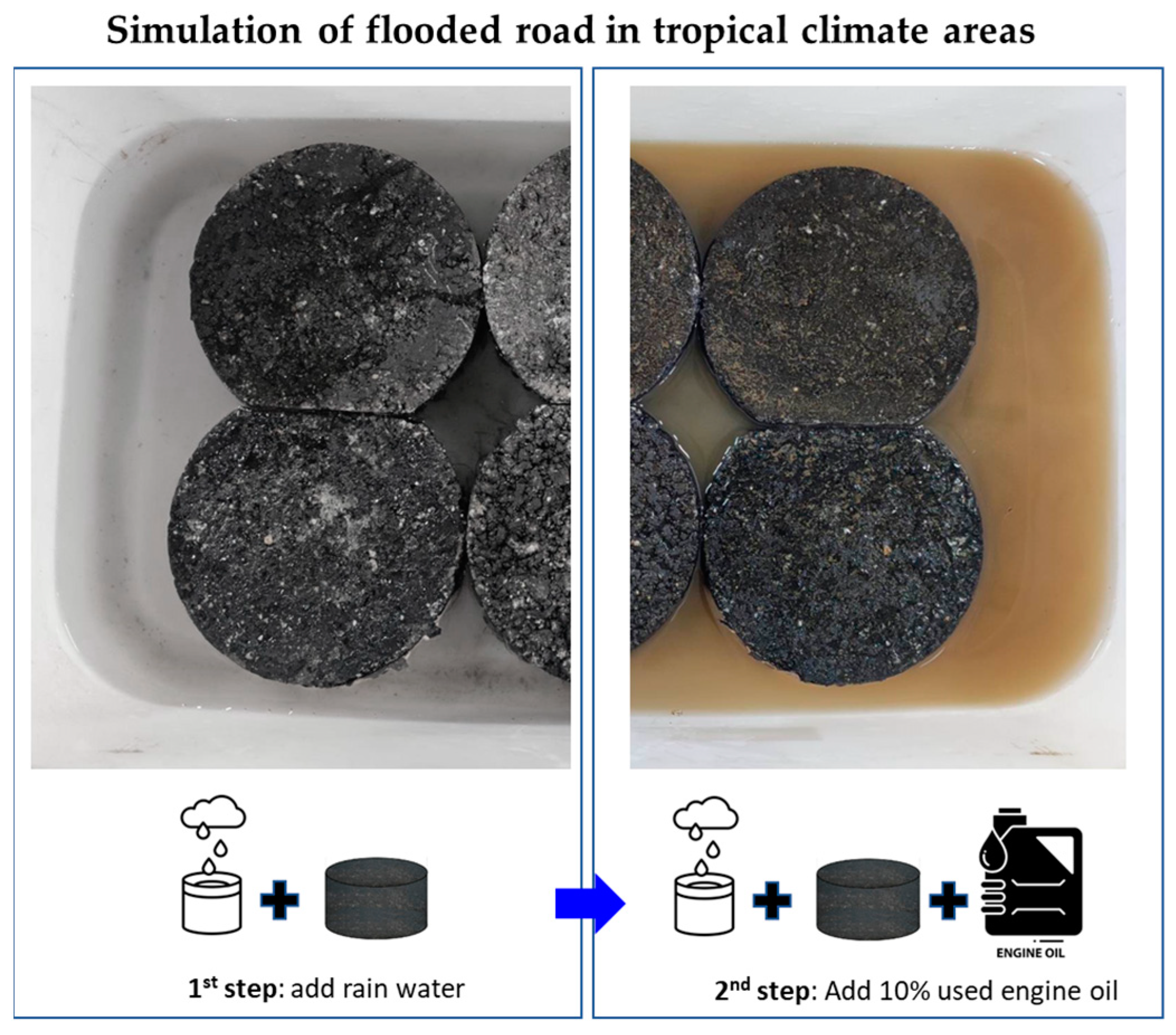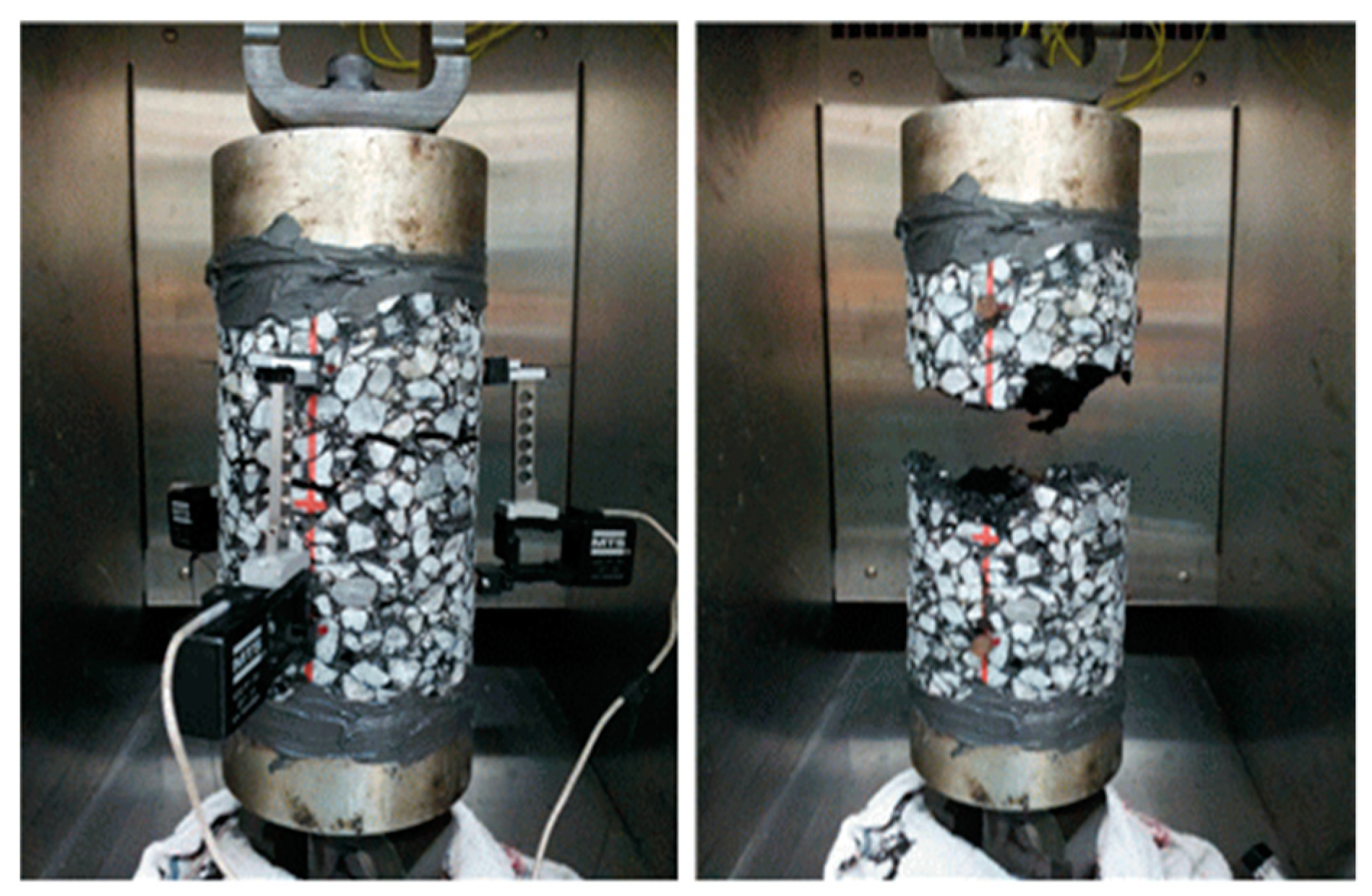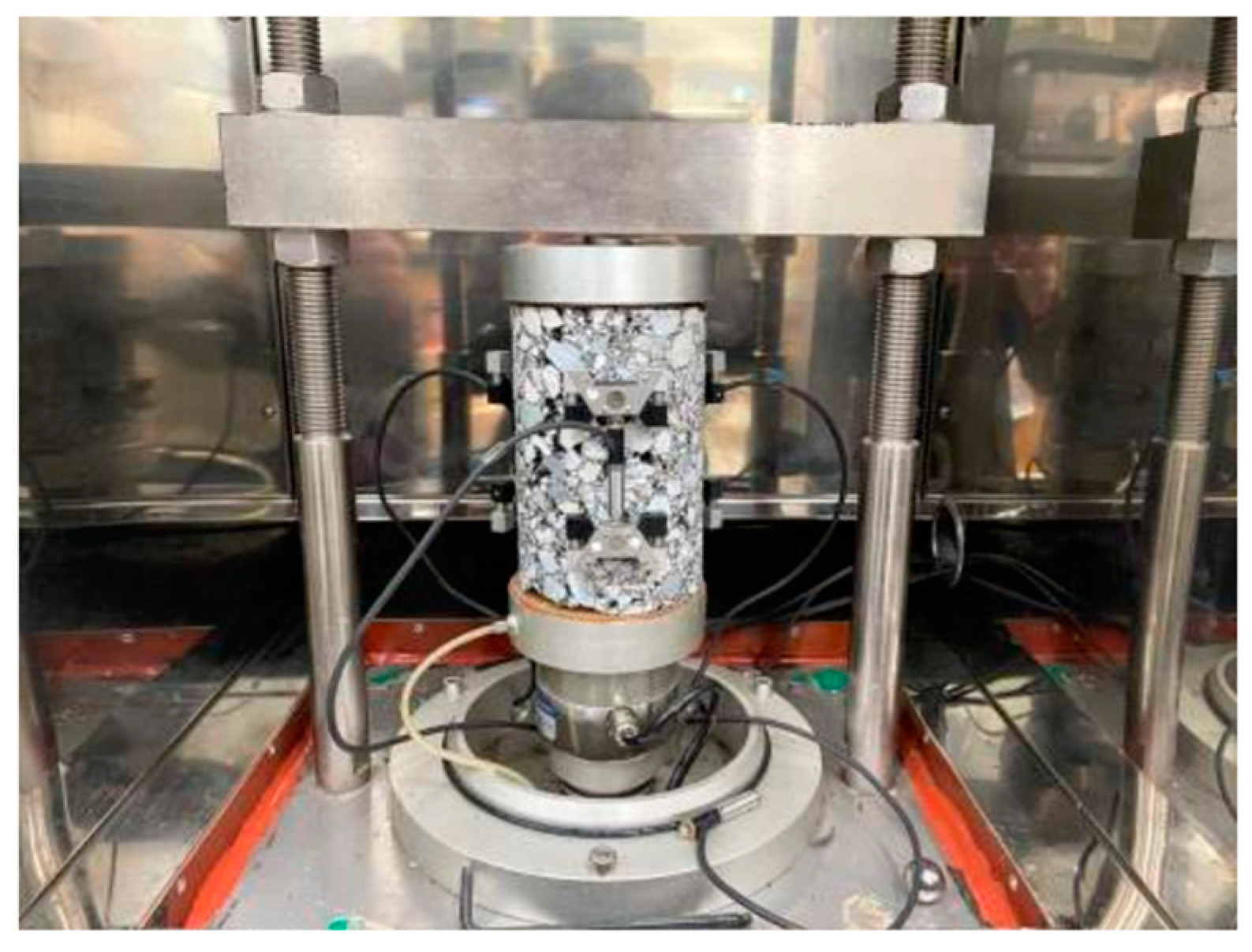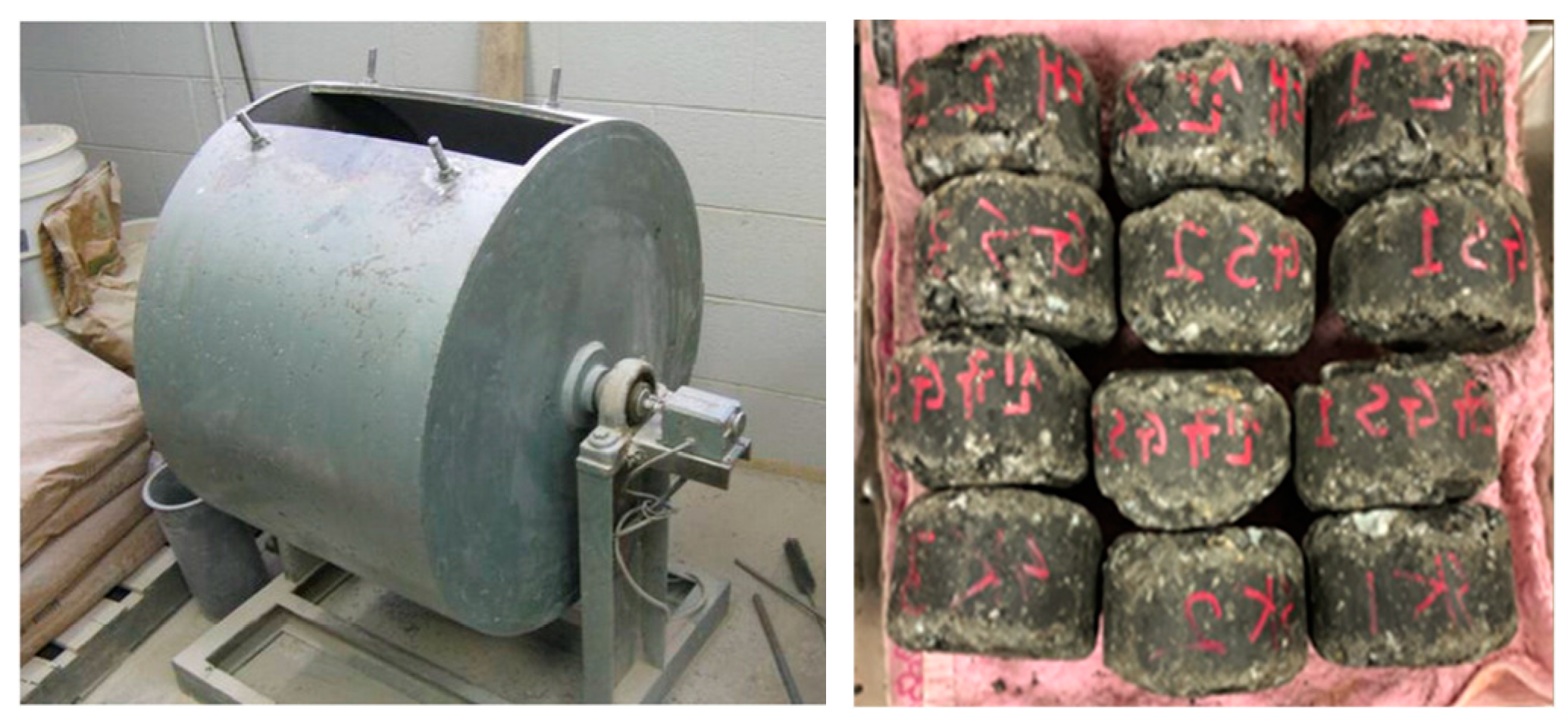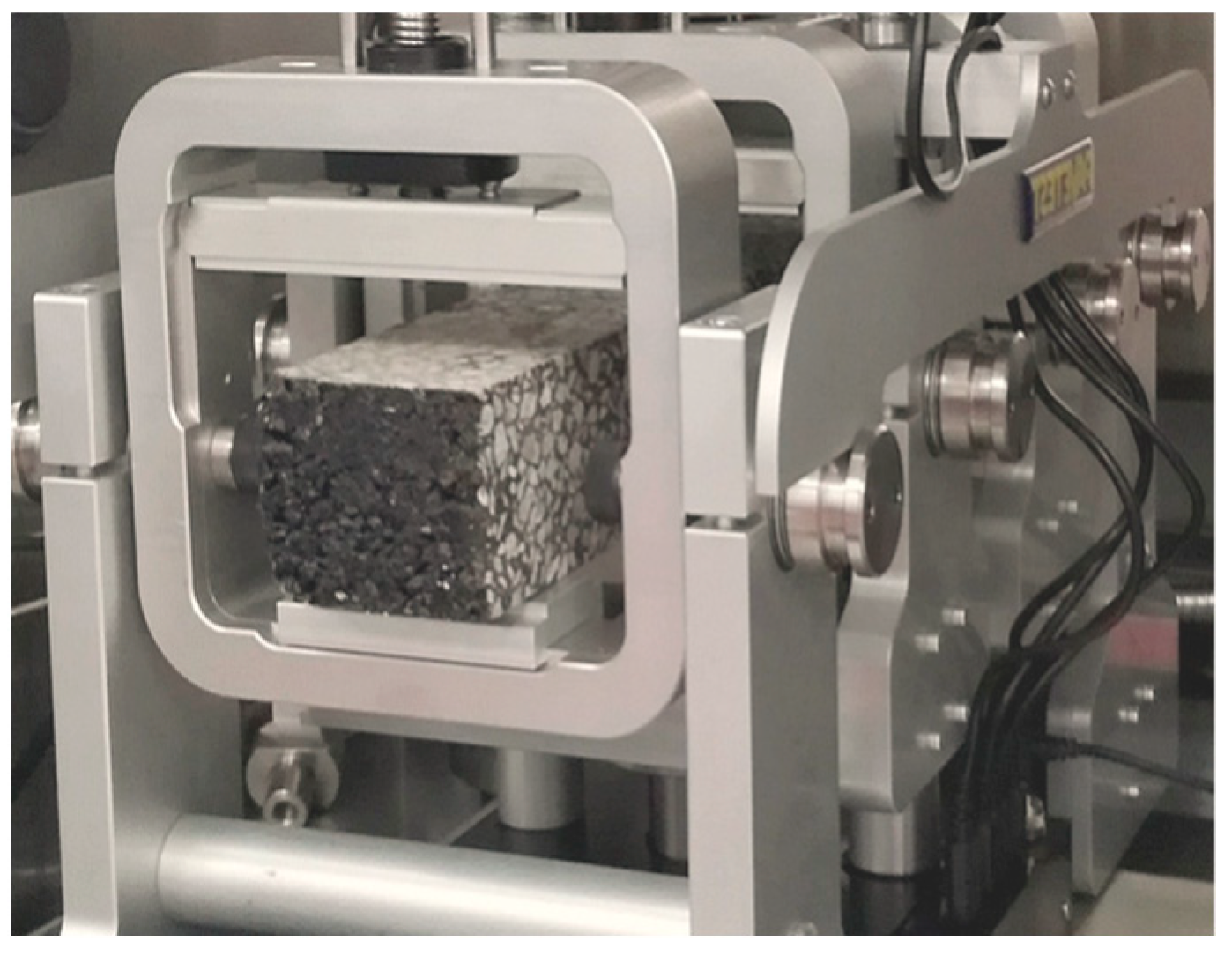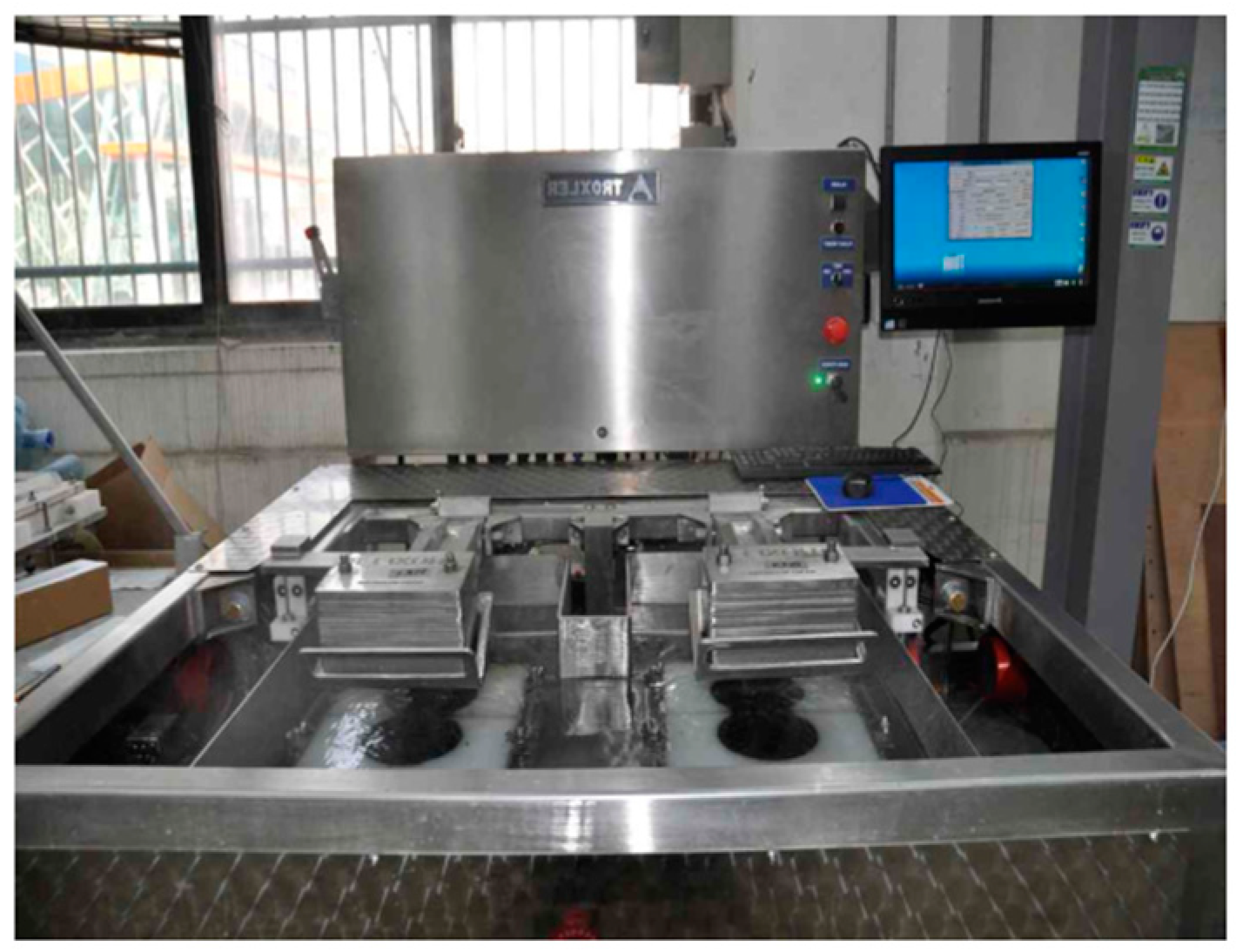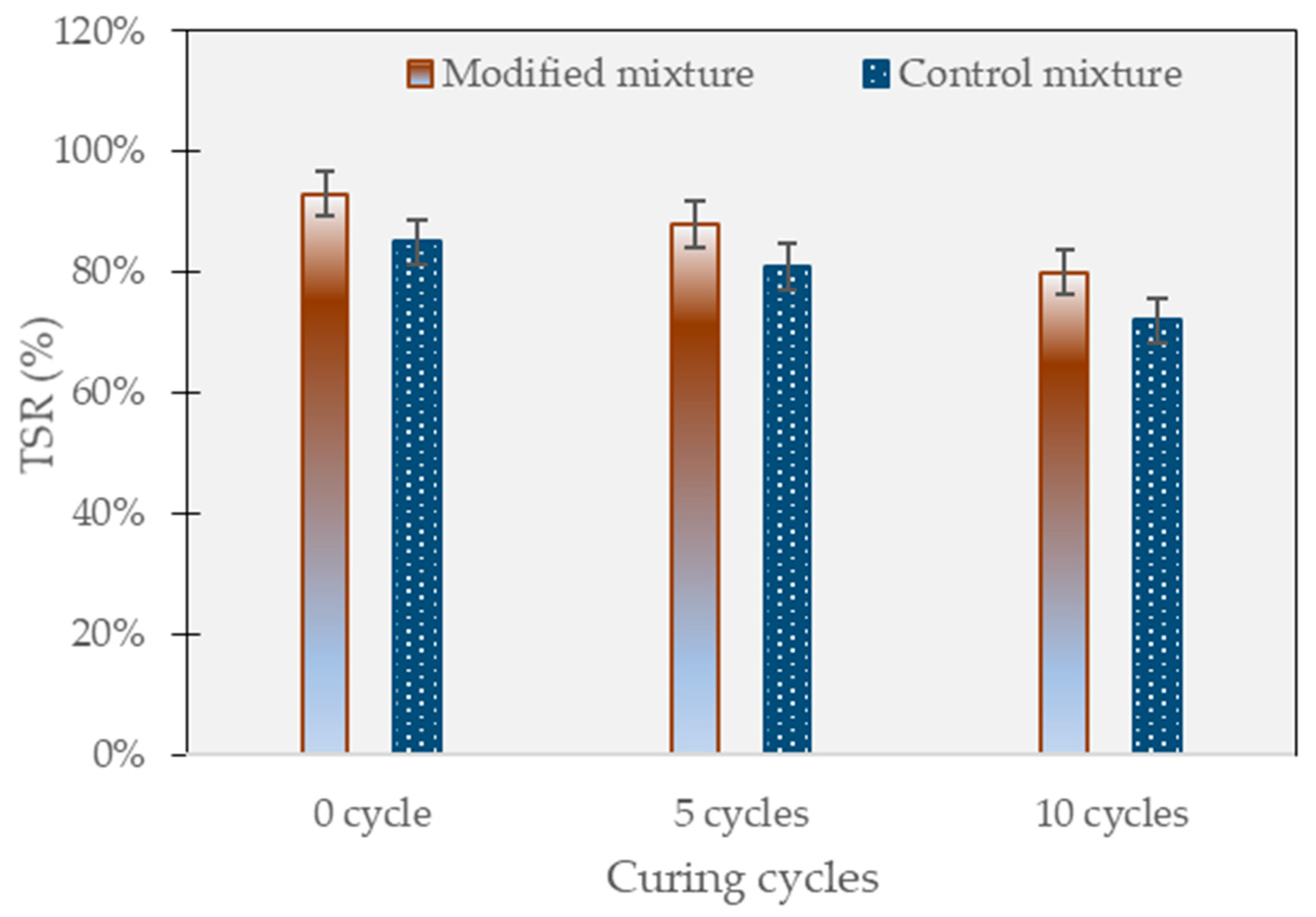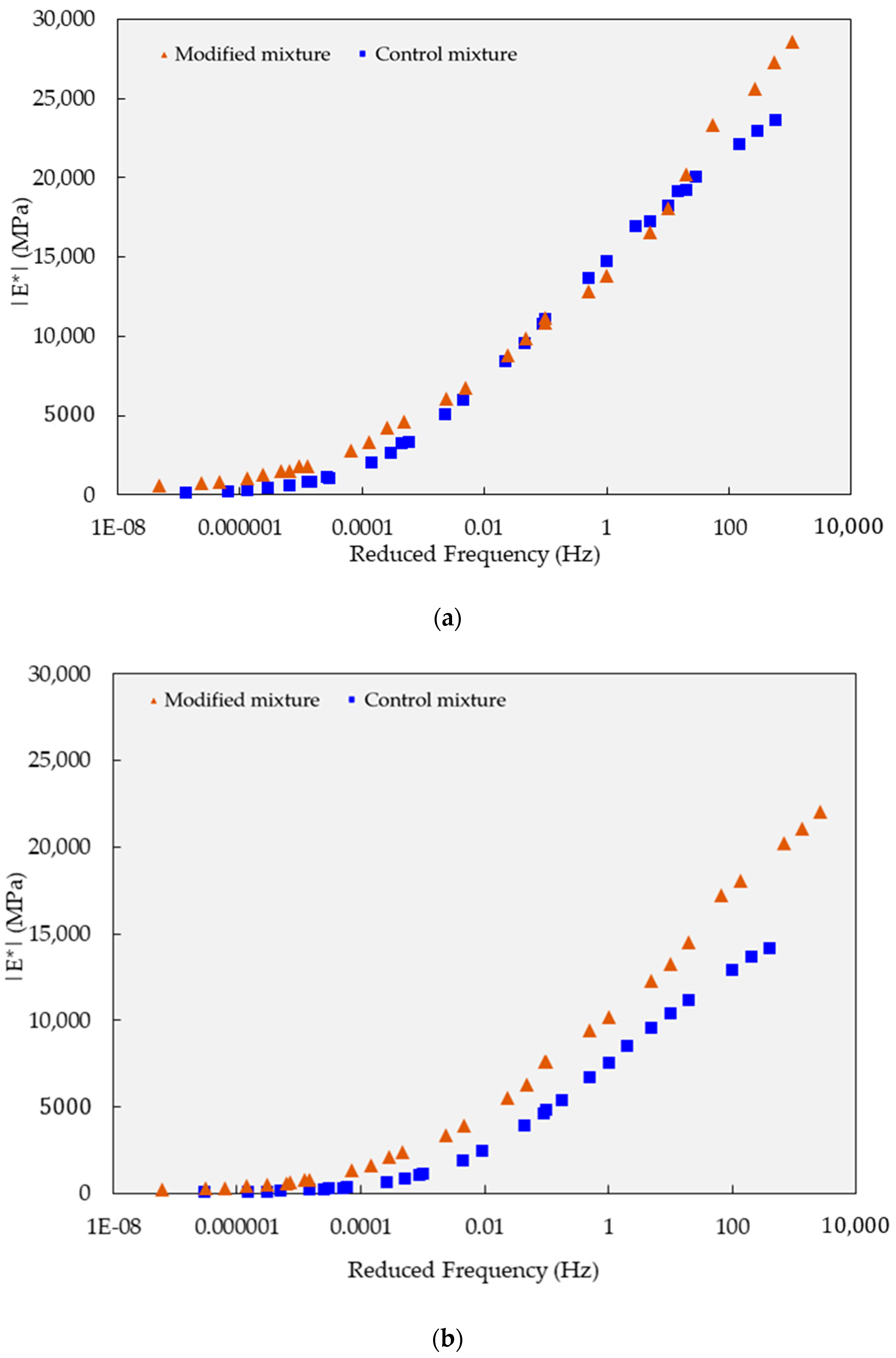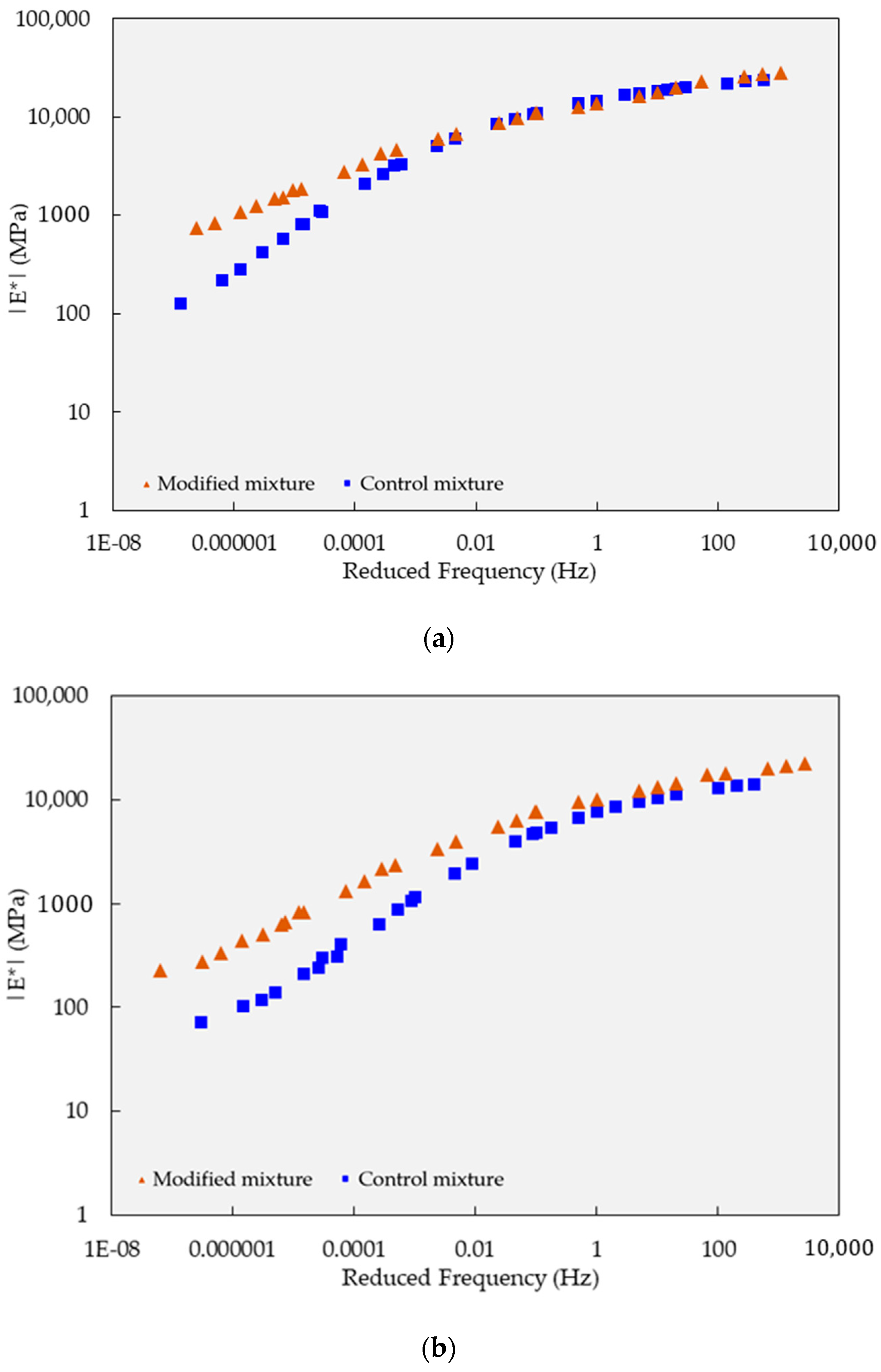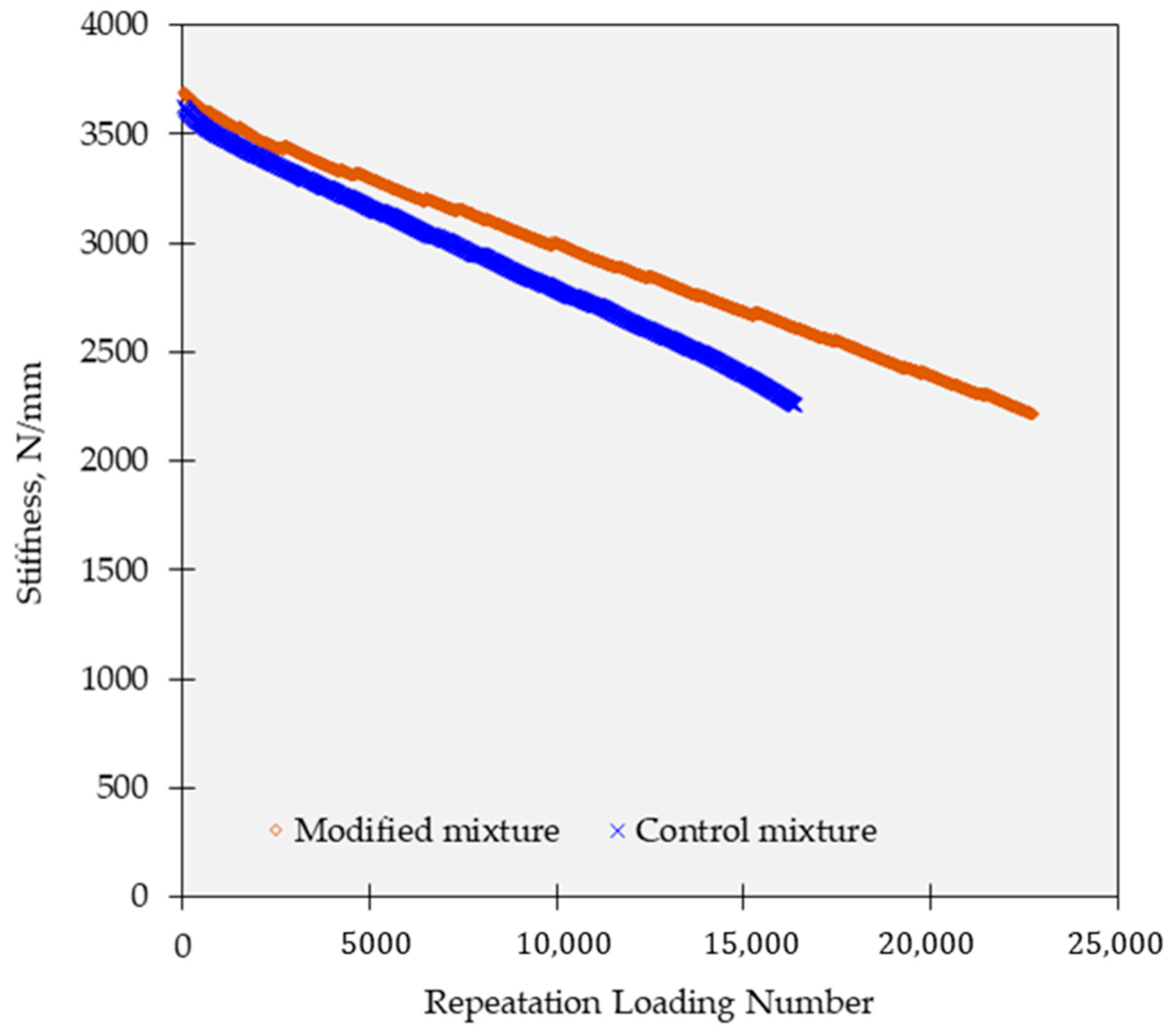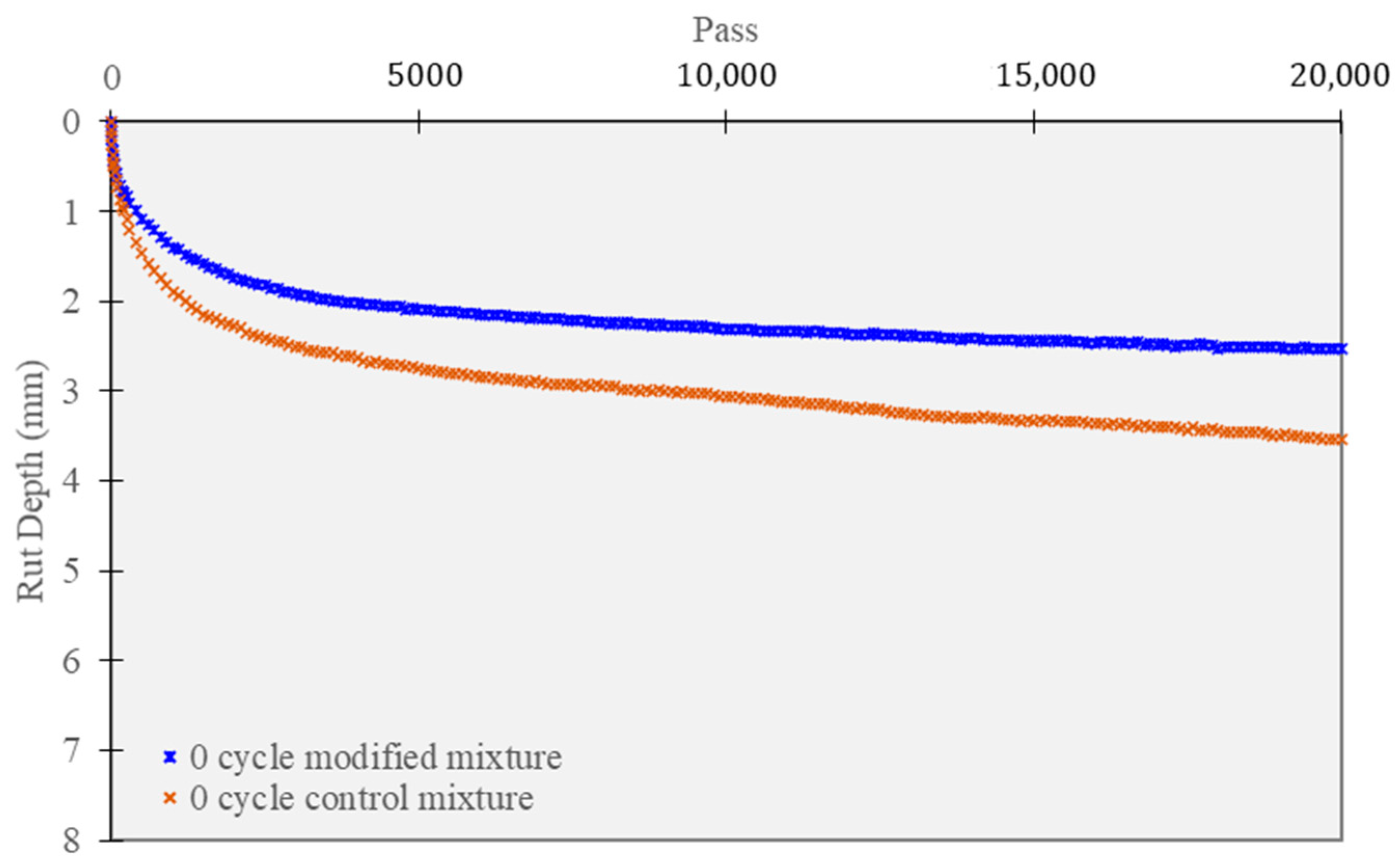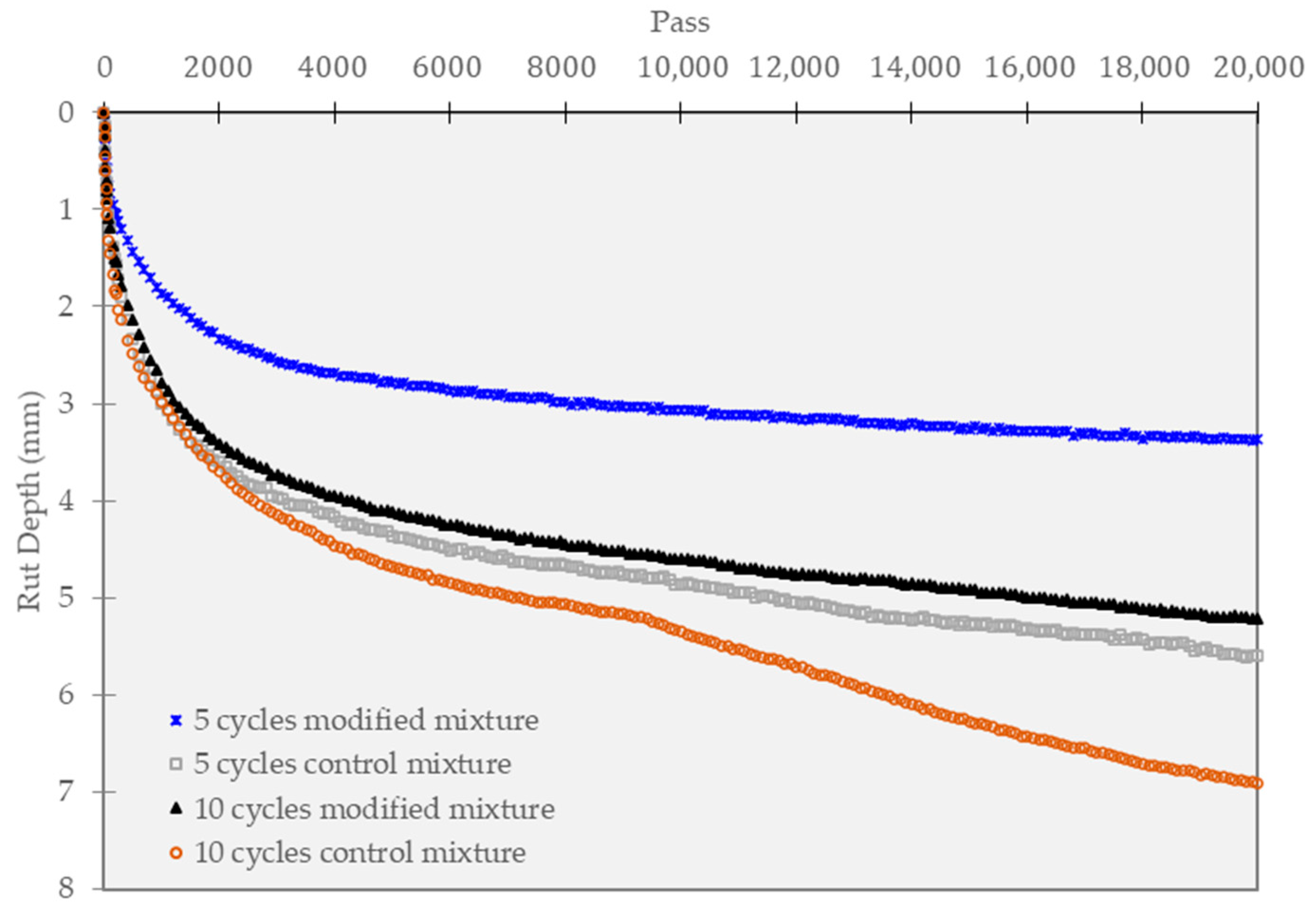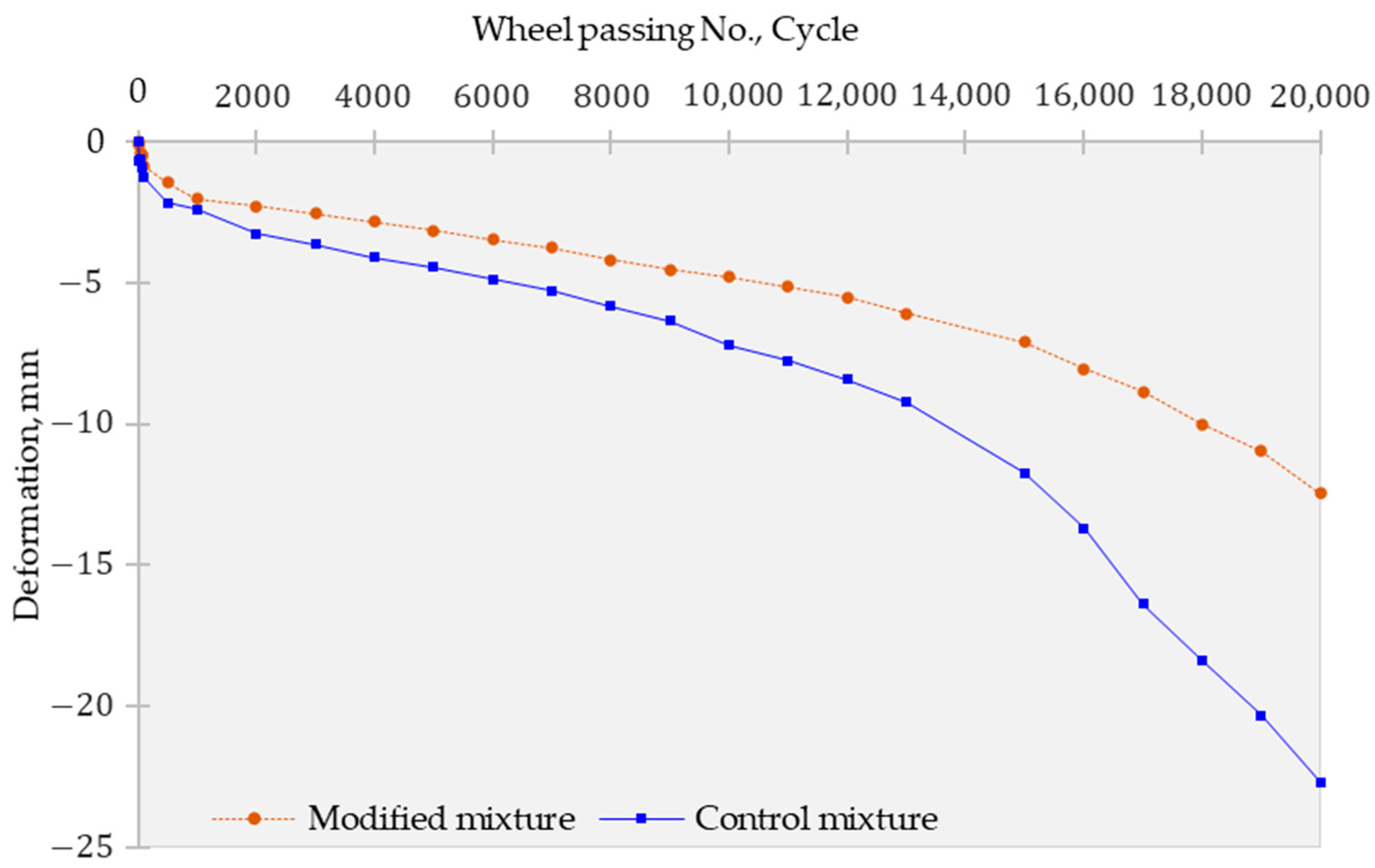3.1. Tensile Strength Ratio Test
In this study, the tensile strength ratio (TSR) was used to evaluate the resistance of the control and modified SMA mixtures to permanent deformation under critical curing conditions. The specimens were subjected to five to 10 cycles of contaminated water curing and air drying in a chamber of 50 °C, simulating the critical curing conditions that occur during the rainy season in tropical climate countries. As shown in
Figure 8, the results showed that the modified mixture had a higher TSR than the control mixture, indicating greater resistance to permanent deformation. This can be attributed to the addition of the polymer modifier, crumb rubber, and epoxy resin, which improved the binder properties and increased the strength and elasticity of the mixture.
The modified mixture exhibited a TSR of 88% after five cycles and 80% after 10 cycles, while the control mixture showed a TSR of 81% after five cycles and 72% after 10 cycles. This indicates that the polymer-modified mixture has better resistance to permanent deformation under simulated critical curing conditions. The coating and water-proof properties of the polymer-modified mixture may have contributed to its ability to withstand the impact of contaminated curing conditions. Additionally, the acid resistivity of the polymer-modified mixture may have played a role in its improved TSR performance. The incorporation of crumb rubber and epoxy in the polymer-modified mixture also likely contributed to its enhanced resistance to deformation. Furthermore, the use of contaminated water in the curing process simulates the harsh conditions of the real-world environment and provides a more accurate representation of the performance of the mixtures. Overall, the results suggest that the polymer-modified mixture is better suited to withstand the harsh curing conditions commonly experienced during the rainy season in tropical climate countries.
3.2. Dynamic Modulus Test
In the dynamic modulus test, the experimental data were analyzed to generate the master curve, as presented in
Figure 9 and
Figure 10. In general, both types of mixtures displayed similar behavior characteristics in terms of modulus of elasticity concerning temperature and load cycle, except under long-term curing conditions.
Further investigating the behavior of the test mixture after the curing process, the polymer-modified mixture demonstrated a significantly higher modulus of elasticity compared to the reference mixture in the high-temperature range, particularly in the high and slow load frequency region.
The reinforcement effectiveness is more prominent when specimens were subjected to 10 curing cycles. After 10 curing cycles, the dynamic modulus values at the high-frequency range indicate that the modified specimens exhibited a significantly higher value of 22,084 MPa compared to the control specimens, which had a dynamic modulus of 14,178 MPa (see
Figure 9b).
Considering the behavior of samples under a low-frequency zone, the dynamic modulus test results after 10 curing cycles at the low-frequency range revealed a substantial difference in the dynamic modulus between the modified and control specimens. As presented in
Figure 10b, the modified specimens exhibited a significantly higher dynamic modulus of approximately 226 MPa, representing an increase of about 213% compared to the control specimens, which had a dynamic modulus of only 72 MPa. This implies that a polymer-modified mixture has superior resistance to plastic deformation, which is an essential factor in the durability and resistance to permanent deformation of asphalt pavements.
Additionally, the polymer-modified mixture also exhibited a remarkably higher modulus of elasticity than the reference mix under high load cycles, indicating a potential reduction in susceptibility to low-temperature-induced cracking. This finding suggests that a polymer-modified mixture may offer improved resistance against temperature-induced cracking, which is crucial for asphalt pavements subjected to heavy traffic and fluctuating environmental conditions. Overall, the higher modulus of elasticity observed in a polymer-modified mixture indicates its enhanced ability to resist plastic deformation under high-temperature conditions, making it particularly suitable for applications where durability and resistance to permanent deformation are crucial factors.
3.5. Hamburg Wheel Tracking (HWT) Test
The HWT test outcomes are illustrated in
Figure 12 for the mixtures tested under 0-cycle curing conditions. Initially, under normal curing conditions (0 cycles), all mixtures displayed a sharp settlement during the first 2000 cycles, followed by a gradual increase in settlement rate. The test findings indicate that the polymer-modified mixture has superior rutting resistance. Specifically, the settlement of the modified mixture was less than 2.52 mm at 20,000 cycles, while the reference mixture’s settlement was higher than 3.53 mm. In addition, the stripping point phenomenon was not observed in any of the mixtures.
Regarding the effect of curing conditions under standard HWT loads, the test results indicate that the reference mixture suffered a significant increase in rutting values compared to the polymer-modified mixture. Analysis of the rutting depth (mm) value, when the wheel load reached 20,000 cycles, showed that the addition of polymer and additives effectively reduced plastic deformation. For instance, as presented in
Figure 13, during short-term curing, the reference mixture experienced approximately 5.6 mm of plastic deformation, while the modified mixture experienced less than 3.4 mm.
Under long-term curing conditions of 10 cycles, the maximum deformation of the control mixture sharply increased from 5.6 to 6.91 mm, while the modified mixture increased from 3.4 to 5.21 mm. Moreover, as it is a water immersion test, the addition of polymer accompanied by the appropriate content of CRP and epoxy was determined to improve moisture resistance. As a result, the asphalt pavement materials with CRP (6%) + Epoxy (3%) showed the highest resistance to stripping.
Additionally, to simulate the overloading effect in tropical climate conditions, the Hamburg wheel tracking test was conducted at an increased load of two times the standard value of 7054.5 N, as shown in
Figure 14. The test results revealed that all settlement amounts were less than 20 mm in the modified mixture (12.4 mm), meeting the criteria when the load was significantly increased. However, it should be noted that the settlement growth rate increased by an average of 2.5 times compared to the conventional loading condition, indicating the potential risk of plastic deformation failure under this condition. In contrast, the reference mixture was significantly impacted by both contaminated curing conditions and the overload effect, with a sudden stripping point observed at 12,000 and a maximum rutting value of more than 22.7 mm.
The Hamburg wheel tracking test results indicate the significant role of the polymer-modified mixture in enhancing the rutting resistance and durability of the asphalt pavement materials under different curing conditions and loading scenarios. The incorporation of polymer and additives into the mixture has contributed to the tightening effect, which led to a significant reduction in plastic deformation and settlement amounts. In addition, the water resistance and acid resistance of the mixture were improved, as a result of the coating and water-proofing effect of the polymer and the proper content of crumb rubber powder and epoxy. The findings suggest that the use of polymer-modified asphalt containing crumb rubber powder and epoxy can be an effective strategy for improving the long-term performance and sustainability of asphalt pavements, especially under harsh environmental and traffic conditions.
Based on the findings from this research, the results suggest the great potential of modified asphalt binder for the durability improvement of asphalt concrete in tropical climate conditions. This can be mainly attributed to the component constituted in the asphalt binder. The modified hot mix asphalt (HMA) mixture comprises three key components: styrene–butadiene–styrene (SBS), crumb rubber powder (CRP), and epoxy resins. Each of these components plays a crucial role in enhancing the mechanical properties of the mixture, resulting in improved performance characteristics.
SBS, as a thermoplastic elastomer modifier, significantly improves the tensile strength of the asphalt mixture. By enhancing the binder’s elastic behavior and crack resistance, SBS allows the modified HMA to better withstand thermal and mechanical stresses. This increased elasticity reduces the likelihood of cracking and enhances the overall tensile strength of the mixture. The inclusion of crumb rubber powder (CRP) in the HMA mixture offers several benefits, particularly in terms of dynamic modulus. The rubber particles present in CRP act as reinforcing fillers, increasing the stiffness of the mixture. This enhancement in dynamic modulus helps the HMA to better resist permanent deformation under traffic loads, reducing rutting potential and ensuring improved long-term performance of the mixture. Epoxy resins, when incorporated into the modified HMA mixture, provide substantial improvements in damage tolerance. These resins introduce additional cohesion and adhesion properties within the mixture, effectively mitigating crack propagation. Through the formation of a durable cross-linked network within the modified asphalt binder, the epoxy resins significantly enhance the mixture’s resistance to cracking, thereby extending its service life.
The combined effect of SBS, CRP, and epoxy resins in the modified HMA mixture results in a material with enhanced mechanical properties and improved performance characteristics. By improving tensile strength, dynamic modulus, and damage tolerance, these components contribute to a more durable and long-lasting asphalt mixture, capable of withstanding various stressors and extending the lifespan of pavement surfaces.
